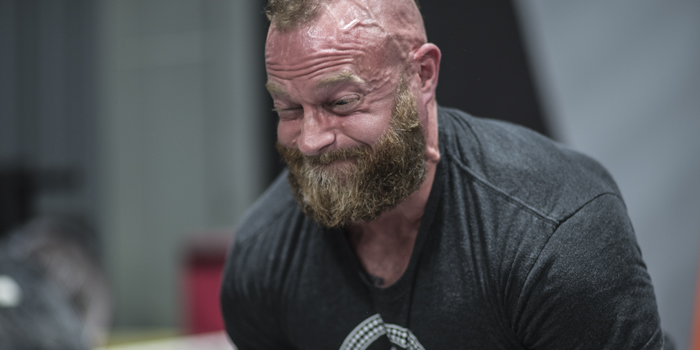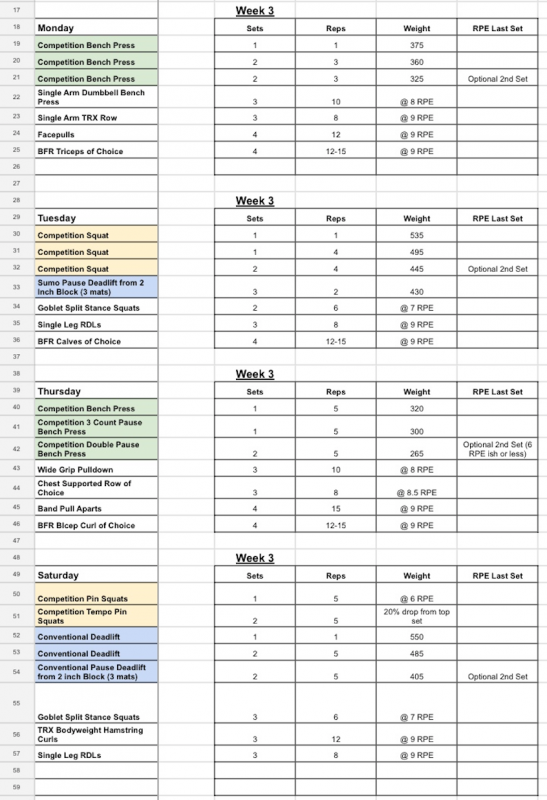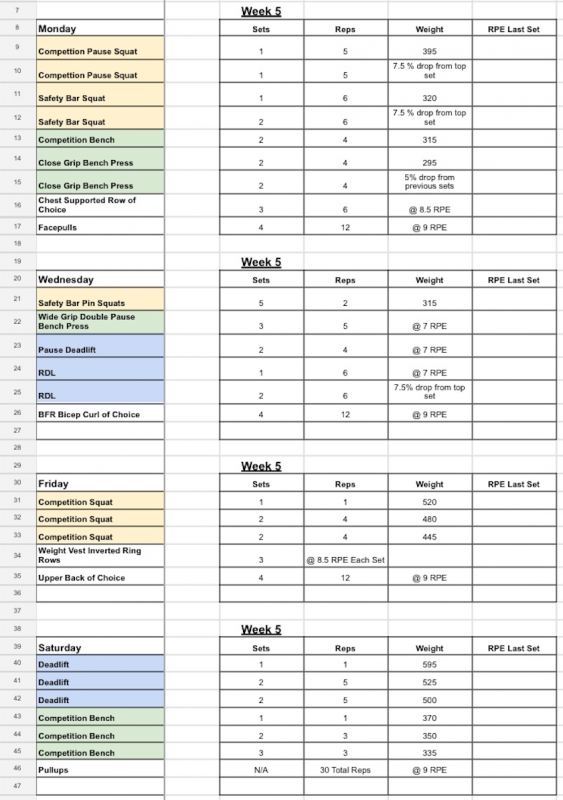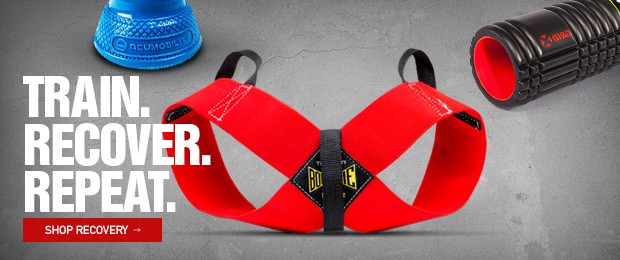
Individualization is paramount in creating successful programming that is optimally suited to each client, but an often overlooked aspect of individualization is injury resiliency and history. It is a no-brainer that if someone is injured they need to adjust training as needed, but when someone is healthy, how often do you see athletes and coaches adjusting training variables to suit someone’s injury past to then prevent injuries in the future? Too often I feel like I see lifters who have a low resiliency to injury but currently are healthy training with programs that are volume and intensity matched to lifters who have shown to be highly resilient to injury. In my opinion, that’s a recipe for disaster. So to highlight the key variables that I have found that need to be adjusted in these situations, I though a case study of two of my strength athletes would show the principles and variations in programming that are going to help in the success of a lifter who has the injury bug.
RECENT: Using Squat Variations to Alter Movement Patterns
I choose these two athletes because they are nearly identical. I joke with them that they are long lost twins: almost identical ages, bodyweight, build, torso, arm, and leg lengths, training age, and powerlifting experience. Both have hit 1600-pound-plus totals at around 205 pounds bodyweight. To give you and idea currently of where their projected numbers are:
Powerlifter A: Patrick Posten (@patrick_gpathletics on Instagram)
- Squat: 565 pounds
- Bench Press: 405 pounds
- Deadlift: 670 pounds
Powerlifter B: Adam Flesner (@adfles on Instagram)
- Squat: 600 pounds
- Bench Press: 410 pounds
- Deadlift: 650 pounds
If there were ever two athletes I have had that I would think would probably have similar programming, it would be these two — but that could not be farther from the truth. They actually probably differ from each other more than any other athletes I have, and that all comes down to injury history and resiliency. Patrick had an ACL tear and reconstruction in high school, but since then he’s never had a single issue, and the ACL no longer affects him in any way. In three years of powerlifting, about the worst thing that has happened is some slight elbow tendonitis from low bar squatting. Other than that, the guy is a tank and can handle pretty much anything I throw at him. Adam, on the other hand, has just about everything wrong with him. He came to me broken and needing to find a way to fix him: two bulging disks in his lumbar spine, bursitis in both knees, undiagnosed issues with his posterior hip capsule on both sides, shoulder pain, and a broken powerlifting heart due to all the frustration he had incurred over the past two years of one injury piling on after the other. Some of these issues are currently bothering him—specifically the knees and hips—and some are in the past but always one rep away from putting him back up on the rehab bus.
Taking these two lifters, let’s break down all the variables that come into play in regard to individualizing their programming. Specifically, let's look at Adam’s needs to keep him progressing and, even more importantly, healthy. Below is a snapshot of a what a week in their current training looks like. It’s obvious from a quick glance that you can see some immediate differences in the structure, volume, intensity, and frequency. Those variables all play big roles, but there’s even more to it than just that, so let’s cover each variable, specifically keying in on how Adam’s programming is individualized to suit his injury history.
Adam Flesner's Program
Patrick Posten's Program
Previous Training Program
The first thing I needed to know above all else is what Adam was doing previously so I could get a gauge of all the following variables. Adam’s previous program was running him down, so I can then use that as a baseline knowing he has to do less than that. For Adam, it was a very standard four-day a week percentage-based daily undulating periodization (DUP) style program, with all three competition lifts performed twice weekly, run in four-week blocks (three weeks on then one-week deload) in a linear progression format. I saw the biggest downfall of this program, in regard to Adam, being that by week three all lifts were probably pushing around eight or nine RPE on both days. Once he got to week three, every day, every lift was heavy, and his body would break down at this point. He was actually doing fairly low volume compared to most DUP style programs, but the intensity and exercise specificity was a bit too much for him.
Individual Lift Differences Based on Past Injury History
When it comes to injury history, the next most important thing to know after injury history is what lifts, in particular, seemed to cause those injuries and during what period of training it tended to occur. For Adam, deadlifts have been the main cause of the majority of his issues, specifically during higher volume and higher rep blocks in his training, during sets that were taken to higher relative intensities. Add in the fact that he is currently experiencing hip pain due to sumo deadlifts, we now have an idea of what we need to avoid in his training. These issues also tend to carry over into his squat, since they are somewhat similar movements. So he will need adjustments there as well, especially since these hips issues have led him in recent months to start developing a more knee-dominant squat which led to bursitis in both knees.
Range of Motion
With Adam’s sumo deadlift, he has been experiencing pain at the bottom position and during the lockout. Since this injury is currently causing issues, I have him avoiding those ranges of motion by pulling from two-inch blocks and stopping just short of lockout on his sumo deadlift. Within that range of motion, he experiences very little discomfort, and this change allows him to continue training this movement pattern in a way that is going to allow him to recover.
For the first week of Adam’s current training block, I also had him start with slightly above parallel pin squats, but after just a week his knees and hips felt better in the squat, so we returned to normal depth.
Exercise Variation
Even though Adam’s main competition deadlift stance is sumo, you will notice I have him doing very little sumo work, and instead, doing the majority of his work conventional. Not only does he not experience the same hip pain conventional, he also historically has had fewer issues with his lower back, oddly, with conventional deadlifts. On top of that, I have him doing pause deadlift work on both sumo and conventional to reduce the weight needed to produce an overloading effect, and also to improve and reinforce proper tension and bracing in that bottom position where most of these issues occur. While all of this may not be optimal for someone like Patrick who hasn’t experienced any issues from deadlifting, for Adam this is the way for him to be able to maintain health while slowly progressing. We use sumo deadlifts as skill practice, but not as an overload effect, where we instead use conventional deadlifts.
There are also some adjustments made on squats to help in regard to the current knee bursitis, to limit overall weight needed on the bar, and to get him back to his previous squat pattern before the hip issues arose. Adam was previously competition squatting twice a week, but we reduced that to just once a week and made up the other squat day of variations, specifically pin squats. Pin squats were something Adam had never done before, so there was the benefit that he kind of just sucked at them and did not need nearly as much weight to overload the movement as if he had done his normal competition squat. Also, between the pin squats and tempo pin squats, we did a great job of reinforcing proper positioning, especially at the bottom, which is skill practice for him to try to regain the even distribution of tension between his quads and hips that he had before.
For bench press, exercise variation did not necessarily come into play in regard to his injury history, but I did have him switch bench setups. He was benching on a narrow bench, so I gave him a new setup option that created the same width bench as in competition, which is going to be more stable and supportive for his shoulders, with the hope to reduce the likelihood of that shoulder injury flaring up again.
Volume
Maybe one the most obvious things to change is volume. Volume has been shown to be the main contributor in fatigue, and usually high levels of fatigue are going to correlate with increasing risks of injury, in particular, overuse injuries. So looking at Patrick versus Adam, if we are totaling the number of sets performed with the competition movements and their variations, Adam is at about half the amount of total work. This simply is because Adam cannot handle the same volumes as Patrick and still maintain his health. When Adam is 100% injury-free, we will most likely uptick this slightly, but still never to Patrick's level. Taking Adam’s past into consideration means I will always take a more conservative approach with his volume, even in times of good health.
Noting back to when I discussed Adam’s previous programming, the total volume here is actually an uptick to what he was previously doing. The big difference instead was the change in both exercise variation and average intensity (the next variable) throughout each workout.
Intensity
Not only is Adam performing about half the total sets on the competition movements and variations as Patrick, he is also performing fewer sets at as high of relative intensities. While the weights are still getting heavy in regard to absolute intensity, he is only performing two to three total sets above a seven RPE on squat and bench press per week. He still has a heavy single in there once a week on all three lifts, and I feel completely safe doing this due to the fact that all of his injuries have occurred during higher rep sets taken to high relative intensities rather than during low rep sets at high absolute intensities. Those heavy singles are programmed around a seven RPE, so in reality, the relative intensity is not that high and is easily manageable for him. Patrick, on the other hand, may have four to six sets on each exercise at a seven RPE or higher, as well as working up sometimes to 8.5 to 9.5 RPE depending on the week — something I try to keep Adam away from.
As discussed, Adam’s total volume is actually higher than his previous programming, but where that is mainly coming from is the low-intensity back-off work. These low relative intensity sets allow him to receive the extra skill practice he needs, but without the fatiguing and damaging effect of high absolute intensity sets.
Frequency
Frequency and volume many times go hand in hand, as there is only so much volume that can be done in one day without running someone down and making them unable to recover for the next workout. So while Patrick can handle very high volumes, equaling a higher frequency as well, Adam has reduced volume resulting in a lower training frequency for the competition lifts. Unless someone is in a rehab state after a significant injury, I will almost always have at least two times per week frequency for squat, bench, and deadlift due to the need for skill practice. I find just once a week is not enough, especially for someone at a more advanced state like Adam. Where Adam varies, though, is that his competition lift frequency is only once a week for his injury-prone lifts, while the other day is a variation of squat and deadlift. And even if Adam becomes 100% healthy, because of his past history, I probably will never move him past two days per week. What I have found for those that are injury-prone is that your muscles and strength levels can recover from three days per week frequency, but the ligaments and tendons tend to not. So for Adam, two days per week will probably be optimal for the remainder of his powerlifting career.
Block Length
Patrick tends to not even really feel his best until around week four, so for him we do a six-week block with five weeks on and a one-week deload. By the end of week five he usually is starting to feel it, and if we push into a six week his performance starts to decrease, so on week six we deload. For Adam, his strength levels may still be good by week five, but the issue is by the end of week three everything starts to hurt, at least with his prior programming. That deload week for Adam more than anything is time for his ligaments and tendons to recover, not his muscles and nervous system. So to take the conservative approach, I had him stick with three weeks on and one week off for the time being.
Autoregulation
Both Adam and Patrick’s programming is fully autoregulated, which can’t be fully seen through the screenshots due to the weights they used being filled in. However, they are running autoregulated programs for very different reasons. Patrick’s program is autoregulated because of his experience and ability to properly rate RPE correctly. When I have a lifter that can do that, I prefer to autoregulate, as its allows weekly progressions or regressions based on how he feels. And for Patrick, that usually is weekly progression. Instead of having to estimate new training maxes each block, Patrick can gauge his strength each week to regulate the intensity to the proper level.
MORE: Back to the Platform After Injury: David LaMartina's Lessons from the Rehab Process
For Adam, though, his program is autoregulated so that he doesn’t push himself on a day he shouldn’t. Before, when he was running a percentage-based program, on days he went into the gym with pain and feeling run down, he kept at the same numbers because that is what the program called for. And because of that pain and fatigue, a weight that should have been easy was then very hard. If Adam’s squat numbers are programmed based on a 600-pound one-rep max, but on a particular day he probably could only squat 565 pounds, those prescribed numbers are going to push his body past what it is capable of. So autoregulating his training is a way to keep him healthy. If one day he heads into the gym and things just aren’t feeling right, he isn’t forced into using any set weights. He instead can autoregulate to match his strength levels for the day and allow his body to properly recover rather than pushing pasts its abilities. Injuries occur when you push the body past what it is capable of handling.
Accessory Movements
Patrick and Adam greatly differ on non-competition accessory movements. This boils down to the fact that Patrick has very high volumes prescribed for all three competition lifts, so there just isn’t much left when it comes to accessory movements. Adam, on the other hand, has significantly less volume from the competition lifts, so to be able to still maintain or increase muscle mass during his current strength cycle, I have him prescribed to do higher volumes from those accessories.
These accessories for Adam also serve a second purpose, and that is to reinforce proper movement patterns and bracing. For Patrick, his accessories are primarily based on hitting muscle groups that may not be optimally trained by the competition lifts, such as horizontal and vertical pulling movements, and upper back and rotator cuff exercises. Adam has those prescribed as well, but he also has movements such as single-leg Romanian deadlifts, goblet split-stance squats, single-arm TRX rows, and single-arm dumbbell presses that are prescribed for the purpose of improving movement efficiency, improving core stabilization, and improving bracing, which should lead to higher injury resiliency. Those are also very low impact movements that produce very little overall fatigue, so they serve the purpose of providing a training stimulus with a very low risk of injury.
Extent of the Deload
The final piece of the puzzle is the extent to which I have both of them deload. Patrick has about a 40% drop in volume and a 20% drop in intensity for his squat and deadlift during a deload week, while his bench has a 40% drop in volume but only a 5% drop in intensity. What I have found with Patrick is that his squat and deadlift need more recovery, but when I deloaded his bench the same way, it tanked. It would take three to four weeks before he felt strong again. Since he has no injury history with the bench press, and his performance is best when keeping intensity up during a deload, we only barely drop the weight now.
As mentioned, the main cause of fatigue is volume, so in reality, intensity can stay high during a deload, and as long as volume is reduced, someone will still recover fairly well. For squats and deadlifts, though, I find most people need an intensity reduction as well to allow the ligaments and tendons to recover, as those don’t heal nearly as well when the intensity stays high.
Adam follows a somewhat similar pattern, but I actually only drop his intensity by 15% on squat and deadlift. The reason for this is that since his volume is already so much lower, he will need that little extra weight on the bar during his deload weeks so that he does not detrain. Similar to Patrick, Adam seems to do better with a bit more intensity on the bench press, so I drop his by 10%, as he has had some injury history with shoulder issues, so I want to make sure that joint gets adequate recovery.
Putting This Into Practice
My hope with this article was to give you a glimpse into the thought process of how I approach the programming of an injury-prone powerlifter. The purpose was not so much to give you a blueprint, as there is no such thing, but instead, give you the ideas and considerations that go into planning the training of someone like Adam. Everyone will be different, and I would put Adam at the extreme range of the spectrum, but this case study shows the extent to what some powerlifters need to do to stay healthy. Taking a one-size-fits-all approach is not optimal. The Bulgarian system produced a ton of Olympic gold medalists, but for every Bulgarian champion, there was probably a dozen more broken and injured lifters that came from that system.
Steve DeNovi is a personal trainer, powerlifter, and strength coach from Springfield, Missouri specializing in strength athletics and post-physical therapy rehabilitation through his company Progressive Resistance Systems. For further questions, you can contact him at sdenovi@gmail.com and visit his website prsontheplatform.com.












Something I'd add is one reason you have to be flexible is so you can appreciate all the non-gym factors which can dictate how someone feels.
In my experience, often a reason why an Adam can't train like a Patrick is not only e.g. genetic factors. It's e.g. Adam has a more stressful job. Adam has two kids while Patrick has none. Adam is going through a divorce while Patrick is in a honeymoon phase. Adam simply is more high strung, neurotic, doesn't sleep as well, while no matter what, Patrick is out cold the moment his head hits the pillow.
That is, there's an awful lot we can't control when managing a client. So we're extra attentive to what we can.